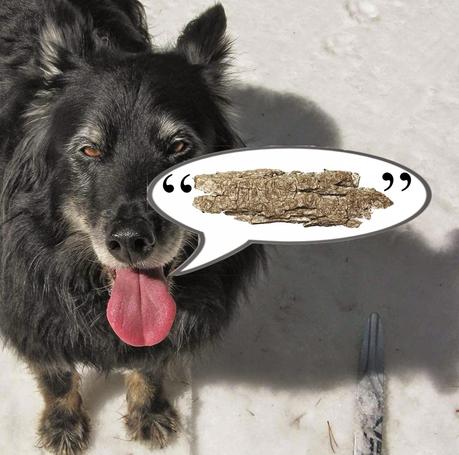
tree-following (noun): informal The practice of observing a tree over the course of a year, and reporting on it monthly, usually online. ORIGIN: early 21st century, from tree + follow; see also Loose and Leafy
Sorry, just kidding, “tree-following” isn’t in the dictionary (yet). But it’s well-established in my vocabulary, as I've followed trees for two years now. This year I chose a lanceleaf cottonwood (Populus x acuminata) growing on the bank of the Laramie River. It started as a bare skeleton, developed a large green canopy, and now is back to a bare skeleton.

February 2014.
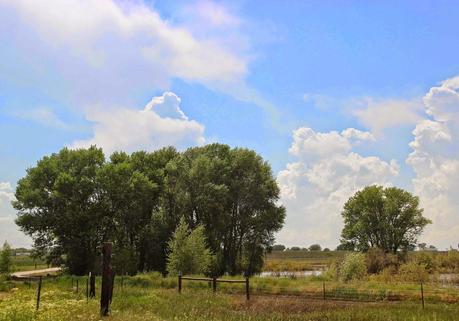
Cottonwoods in full summer dress, June 2014 (my tree on right).
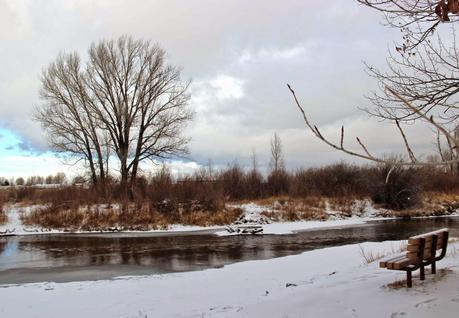
My tree and Rich's bench in early December 2014.
I’ve learned a lot about this tree – its height, when it flowers (and which sex appears first), when it casts its seeds to the wind, what it does all summer, and when the leaves turn color and fall ... and also how cottonwoods have figured prominently in the rural American West. But I’ve pretty much ignored the bark. That’s because it’s humdrum compared with other trees ... not so much other trees here, but rather those elsewhere with their colorful trunks decorated in lichen, fungi and even plants. Is it our climate? Is it too cold? too dry? As always, tree-following leads to questions.
Beautiful old tree in County Durham, UK. Courtesy Phil Gates – The sweet chestnut that refuses to die.
The cottonwood’s leaves are long gone, so it’s time to examine the bark. Most noticeable is the difference between young and old. Young bark reminds me of the cottonwood’s cousin, the quaking aspen (also a Populus – P. tremuloides).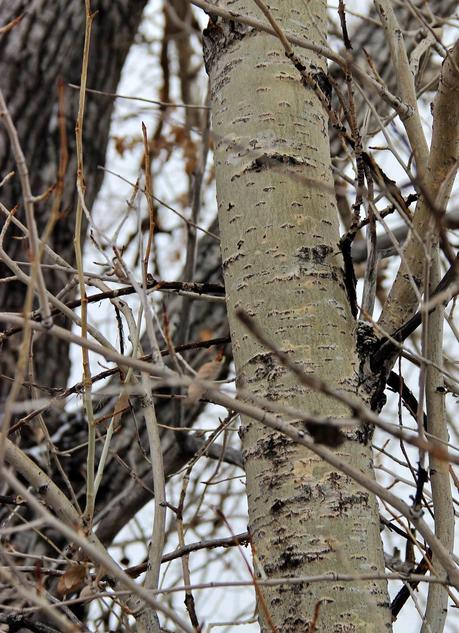 With age, dark furrows fracture the pale bark.
With age, dark furrows fracture the pale bark.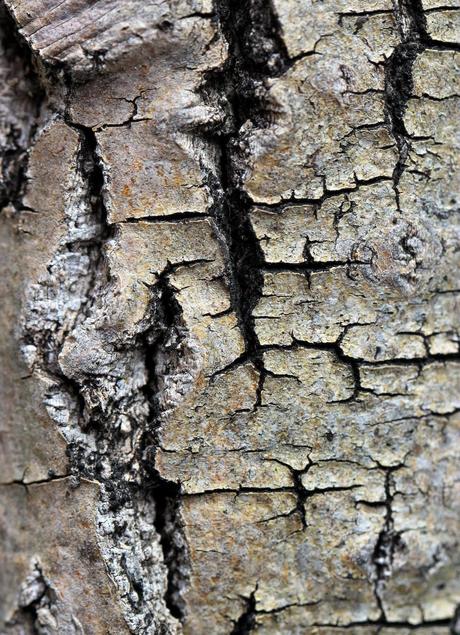
I believe there’s a little lichen between the furrows! (orange blotches)
Old bark is darker, thick and deeply furrowed. Color varies from brown to shades of gray and almost black.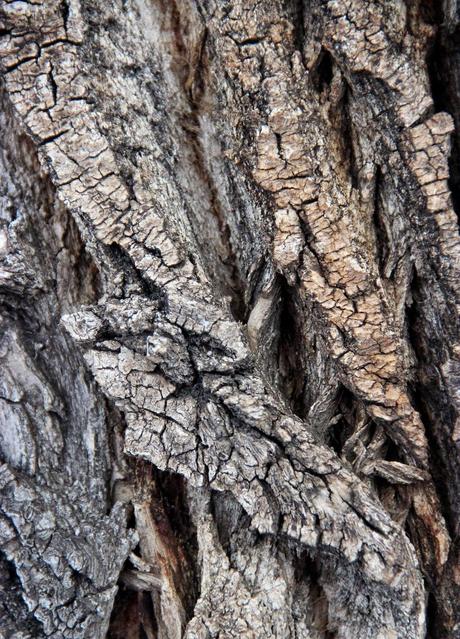

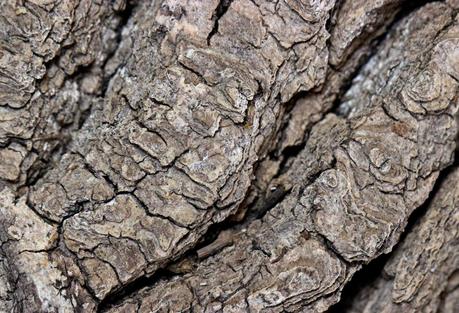
This bark looks like a Google Earth view of buttes, cliffs and drainages!
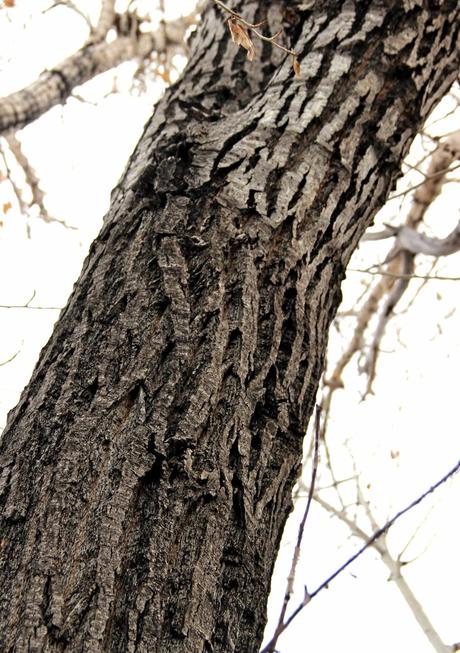
Looking up-tree at older and younger bark.
The robin’s nest Mary spotted in September is easy to see now. Will she (the robin) be back next year? I’ll let you know.
Nest dusted with snow.
Looking close, I found entrances to other homes ... whose? woodpeckers?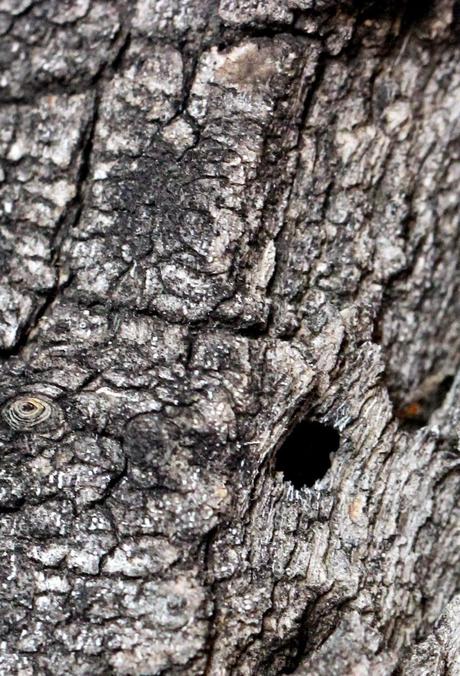
 Probably not woodpeckers ... the entrances are only five millimeters across ;-)
Probably not woodpeckers ... the entrances are only five millimeters across ;-)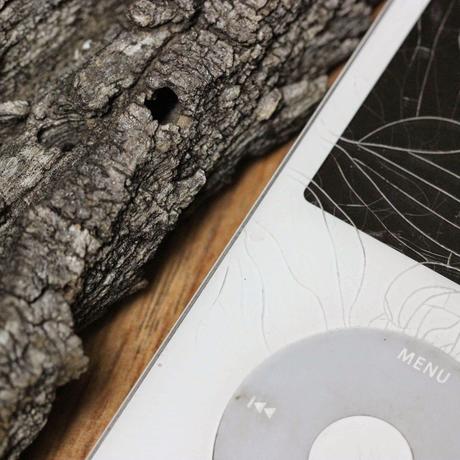 This year’s tree-following has given me a rich collection of cottonwood memories. The most vivid are wind-related, for wind and cottonwoods are inseparable. Wind sends the cottony seeds flying, and makes fresh young leaves dance in the sunshine. Cottonwood leaves whisper in summer breezes, and howl in gales.
This year’s tree-following has given me a rich collection of cottonwood memories. The most vivid are wind-related, for wind and cottonwoods are inseparable. Wind sends the cottony seeds flying, and makes fresh young leaves dance in the sunshine. Cottonwood leaves whisper in summer breezes, and howl in gales.I'm not alone in my memories. Those who experience wind in cottonwoods often are left with strong impressions.
“This peculiarity of the foliage of the cottonwood is quite remarkable, so that it is said the air is never so still that there is not motion of cottonwood leaves. Even in still summer afternoons, and at night when all else was still, they [tribes of the Great Plains] could ever hear the rustling of cottonwood leaves by the passage of little vagrant currents of air. And the winds themselves were the paths of the Higher Powers, so they were constantly reminded of the mystic character of this tree.” Melvin R. Gilmore (1919)
“From the upper branches of the cottonwood trees overhead – whose shimmering, tremulous leaves are hardly ever quiet, but if the wind stirs at all, rustle and quiver all day long – comes now and then the soft melancholy cooing of the mourning dove, whose voice always seems far away.” Theodore Roosevelt (1888)
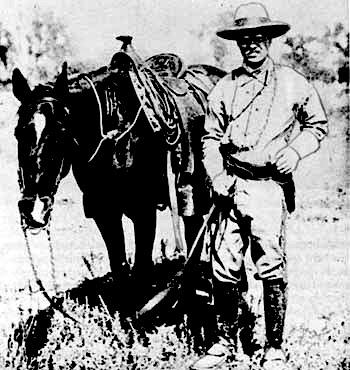
TR at a roundup. Our 26th president loved the American West and all things symbolic of it.
In The Song of the Lark (1915) Willa Cather described cottonwoods as “wind-loving trees ... whose roots are always seeking water and whose leaves are always talking about it." Ed Abbey (1956) saw them more darkly. He lamented the decline of the American West, now populated by phantoms “dying of nostalgia and bitterness”. He could hear them “shivering, chattering among the leaves of the old dry mortal cottonwoods down by the river – whispering and moaning and hissing with the wind.”It will be another six months before cottonwood leaves emerge and grow large enough to dance, whisper and howl in the wind. Laramie winters are long! So I kept the bark I had brought home to photograph, and put it on a table to remind me of summer days ahead.
 Sources
SourcesAbbey, Edward. 1956. The Brave Cowboy. Dodd, Mead & Co.Cather, Willa. 1915. The Song of the Lark. Houghton Mifflin Co.Gilmore, Melvin R. 1919. Use of plants by the Indians of the Missouri River region. Bureau of American Ethnology.Roosevelt, Theodore. 1888. Ranch Life and the Hunting Trail. The Century Co.
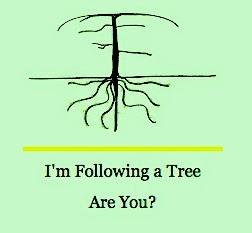 For more tree news visit December's gathering, kindly hosted by Lucy.
For more tree news visit December's gathering, kindly hosted by Lucy.